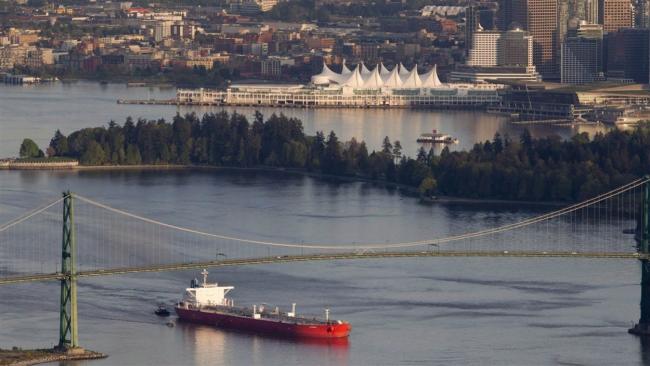Articles Menu

Finance Minister Bill Morneau announced on May 29 that the Government of Canada will buy the existing Trans Mountain pipeline system from Kinder Morgan at a price of $4.5 billion.
When asked about the cost to build the expansion during his press conference, Mr. Morneau was cagey. He refused to explain that $4.5 billion simply buys Ottawa the rights to what exists today — a 65 year old pipeline serving B.C. and Washington State, storage facilities and a one-berth marine terminal that sends modest volumes of diluted bitumen to California markets.
The Texas based company — forged from the executive offices of Enron — plowed ahead anyway. It relied on the National Energy Board (NEB) as an industry-captured regulator to help in the cover-up of the project’s commercial challenges.
By the time the expansion is built, the price tag for nationalizing the existing assets and building the expansion will cost Canadians upwards of $15 - $20 billion.
That's because the $7.4 billion capital cost for the project estimated in February 2017 will likely exceed $9 billion by the time an up to date budget is prepared. Then there is $2.1 billion in financial assurances required for the land based spill risk and $1.5 billion Oceans Protection Plan for marine spill risk that Ottawa has already agreed to.
The Texas based company — forged from the executive offices of Enron — plowed ahead anyway. It relied on the National Energy Board (NEB) as an industry-captured regulator to help in the cover-upof the project’s commercial challenges.
Then, the company played the huge egos of desperate politicians who based project approval on back room deals rather than proper due diligence.
Ottawa never did the job it should have to protect the public interest. It never understood the project’s compromised financial case, or how it was cobbled together.
To justify the "national interest" claim for Trans Mountain’s expansion, Ottawa has made up numbers on jobs and oil revenue benefits.
Ottawa claimed 15,000 construction jobs when Kinder Morgan’s application to the NEB explicitly stated it expected an average of 2,500 — and these would exist only for two years during construction.
More recently Ottawa has claimed a $15 billion a year cost from lack of pipeline capacity. In Calgary last week, Prime Minister Trudeau said, “We are losing $15 billion a year because we are trapped to the American market.”
Natural Resources Minister Jim Carr also points to $15 billion annually as justifying Ottawa’s support. He says, “there is value in getting a better price for our product instead of the discounted one now that costs us $15 billion a year.”
Alberta Premier Rachel Notley, also regularly claims this loss. Trans Mountain’s expansion “will contribute … roughly $15 billion to the Canadian economy”, she says.
This “$15 billion” claim began peppering political soundbites in February, around the time Scotiabank released “Pipeline Approval Delays: the Costs of Inaction.”
A cursory read of Scotiabank’s report reveals a passing mention to $15.6 billion a year. But Scotiabank doesn’t rely on that figure. If no new pipeline capacity is built, Scotiabank says the annual impact will be $7 billion — less than half what Ottawa and Alberta say.
How did Ottawa and Alberta come up with $15 billion in lost revenue from lack of pipeline capacity?
I contacted the Prime Minister’s Office and was re-routed to Minister Carr’s. NRCan confirmed no internal assessment. Scotiabank was their primary source.
Premier Notley’s office confirmed Scotiabank as its only source.
I called the bank. The annual loss predicted (if no new pipeline capacity is built) is $7 billion, not $15 billion.
Did anyone in government read Scotiabank’s report beyond bullet points?
Still, it’s a big number. How is it that some of the most sophisticated heavy oil conglomerates in the world find themselves trapped taking an unfair price in U.S. markets costing $7 billion a year?
The short answer — they don’t. Scotiabank’s report is a work of fiction.
Prime Minister Trudeau’s characterization of sophisticated big oil companies being “trapped” reveals his lack of understanding of how the industry is structured.
Oil producers knew a bitumen export plan would increasingly expose them to the volatile light-heavy discount. They adopted a variety of price mitigation strategies beyond integrating operations with refineries they own in the US. This is why, for example, Suncor CEO, Steve Williams can tell shareholders, “We have virtually no exposure to the light/heavy differential."
Husky has none of their barrels exposed, while less successful strategies at Cenovus have left 40-50 per cent of their production at risk.
What is the aggregate impact of these industry-wide strategies? Only one in ten barrels of crude oil produced in Canada — about 400,000 barrels a day — are exposed to the volatile light-heavy discount. Now the expected light-heavy differential is within the expected range for quality and transportation costs, there is no loss at all.